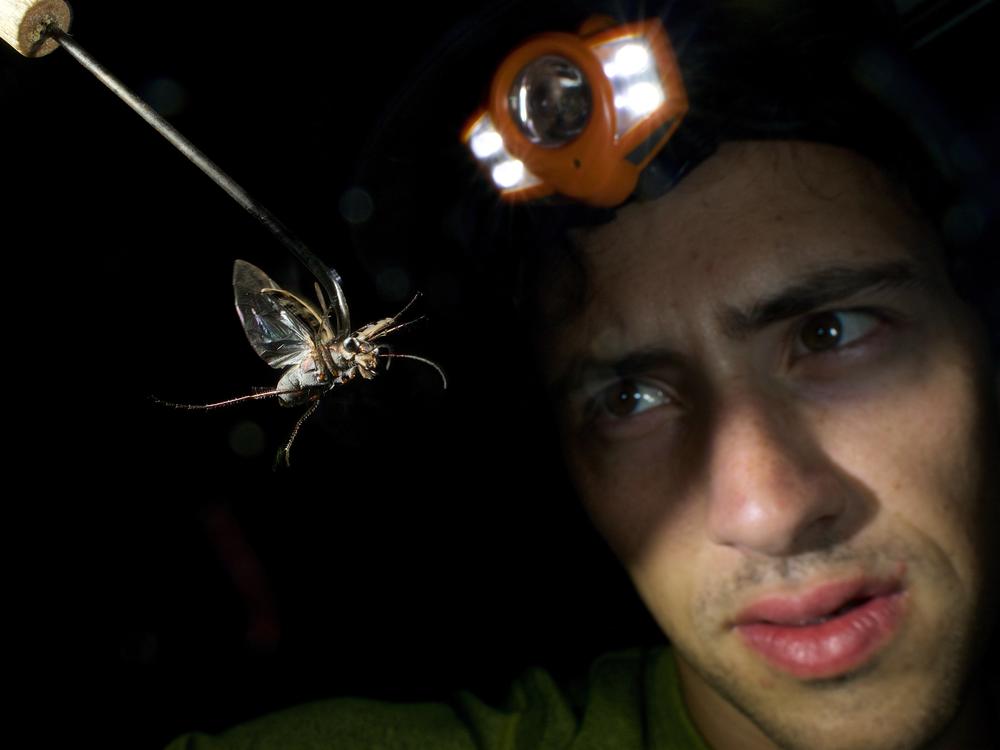Section Branding
Header Content
To escape hungry bats, these flying beetles create an ultrasound 'illusion'
Primary Content
"Lots of things fly at night," says Harlan Gough, a wildlife biologist with the U.S. Fish and Wildlife Service. Nightfall can set the stage for an acrobatic high-stakes drama in the air — a swirl of bats and their prey each trying to outmaneuver the other in aerial pursuit and escape.
"It is life or death for a lot of these insects to get across the sky," says Gough. Bats are skilled nocturnal hunters that use echolocation to find, track, and catch their prey. "When [bats are] cruising through the night sky," he says, "they're sending out a pulse, listening for a response."
These ultrasound pulses are like an acoustic strobe light: They "illuminate" the night air with a sonic search beam that allows bats to home in on their next snack. But insects have evolved an array of strategies to avoid a bat's attack.
In the latest twist in our understanding of this arms race, Gough and his colleagues describe in new research published in Biology Letters that tiger beetles — big-eyed, long-legged insects with pincer-like jaws — produce their own ultrasound in response to a bat's ultrasound. The beetles, they suggest, do it to trick their predators into thinking they're toxic, allowing them to fly away, unharmed.
How moths use ultrasound against the bats
Numerous species of moths have found ways to turn bats' ultrasound into an advantage. Many species have evolved eardrum-like structures that can detect bat echolocation, which gives them escape options. Sometimes, they make a quick course correction to evade the bat closing in on their position. "Another strategy," says Gough, "is they'll fold their wings up and just fall to the ground."
Using a special organ on their thorax, some moth species produce their own ultrasound in response. One reason is to advertise to the bats that they'll make for an unpleasant meal. "With that strategy," explains Gough, "you make that sound, the bat swoops in on you, but it's eaten something similar in the past and known it's really toxic." And so the bat leaves well enough alone.
He says we do something similar with certain insects. "The same way that you grab a yellow jacket once when you're a kid and you learn pretty quickly to not grab anything with black and yellow stripes." It takes just one unpleasant experience for a bat or a person to generalize their avoidance behavior.
When a bat does close in on an insect, it speeds up its echolocation pulses into a "terminal buzz" to better know the moment-to-moment location of its prey to be able to catch it. During this buzz, some types of moths generate enough ultrasound noise to jam up the bat's ability to find it.
Gough knew that tiger beetles also produce ultrasound and wondered why — and whether they were doing something similar to these moths.
Dark nights, beetles, and an occasional scare
To study the beetles, Gough spent two summers as a graduate student at the University of Florida camping in southeast Arizona. Each night, he'd go to bed in his tent and set his alarm for one in the morning. He'd then set out by foot, under the stars, to search the dark mountains and canyons with his headlamp for tiger beetles. "It was like a long drawn-out nocturnal Easter egg hunt where once in maybe a week, you'd find one possibly," he recalls.
Gough came face to face with rattlesnakes in his search. One night, Gough heard something big shuffling in the darkness, and getting closer. He was terrified. "I was wondering, 'Who the heck else was out here in the middle of the night?,'" he says. Once it came within 15 feet, he finally got a good look at the source of the commotion. It was a javelina — a pig-like plant eater. The two eyed each other in the moonlight before parting ways.
During those two summers, Gough ultimately succeeded in finding seven species of tiger beetles. Each time he found one, he'd tether their outer shells to a thin rod with a bit of wax and suspend them in the air. Gough would blow a puff of air at them, triggering them to fly. He'd then play an audio recording of an echolocating bat, its ultrasonic pulses speeding up as it closed in.
"When you get to that feeding buzz," Gough explains, "and that beetle knows that bat is right on its tail, they respond. And what you hear are these little clicks. Those clicks are made by the beating wing. So it's a very clear response to the bat's echolocation."
A toxic mimic
When Gough heard the sputter of ultrasound from the tiger beetles, he knew it wasn't nearly enough sound to jam a bat's sonar. He wondered whether maybe the beetles were signaling to the bats that they were toxic, so he conducted an experiment where he directly fed them to big brown bats.
"And what we found is that they ate all these different tiger beetles," he says. "They munched them straight down."
Gough did an analysis that showed that the ultrasonic pulses of tiger beetles and tiger moths (no relation) are similar acoustically. And because tiger moths are toxic to bats, that left Gough with a hypothesis.
"It's likely," he says, "that these tiger beetles are producing the [ultra]sound to sound like other similar moths." That is, he believes these beetles are mimicking the bad-tasting moths to trick the bats into not eating them either — even though they'd be a perfectly palatable meal.
"I'm quite convinced by their data," says Hannah Ter Hofstede, a biologist at the University of Windsor who wasn't involved in the research. "Of course, I think that there's more that they could do and they say that there's more that they can do."
Specifically, she says there's an obvious next experiment to really nail down what's happening — "to show that if a bat is attacking one of these tiger beetles in flight and they produce the sounds, that the bats will avoid eating them."
Ter Hofstede also wants to know how much spatial overlap there is between the tiger beetles and the toxic moths because such mimicry only works if there's "a reliable correlation between the signal and the bad taste," she says. "If there's too many cheaters in the system, the predators aren't gonna learn very effectively."
Most examples of this kind of mimicry are visual — a tasty species tricks a predator by looking like a toxic species. But Harlan Gough says the tiger beetles show it happens with sound too.
"In the night sky," he says, "there's just so much that we don't realize because we can't see it — it's hidden to us. The stuff going on behind the curtain is really exciting."


